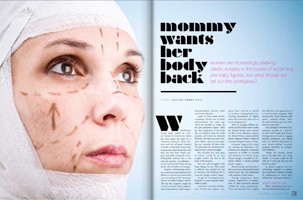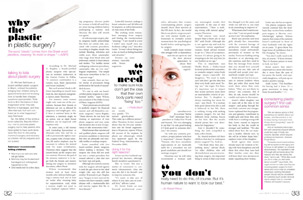Shelley Hawes Pate recently interviewed Dr. Bogdan regarding the Mommy Makeover procedure. His commentary is included in the feature article of the Dallas Child and Fort Worth Child magazines.
Mommy Wants Her Body Back
Women are increasingly seeking plastic surgery in the hopes of reclaiming pre-baby figures; but what should we tell our little protegees?
(This is a reduced version of the article. For the original, please click the magazine pictures.)

When Kirsten Lester shyly called her closest friends to reveal news about her stint under the knife for a “mommy makeover,” their reaction took her off guard. Instead of shock or reproach, one by one, several came clean about the work they also had done. Plastic surgery, especially among the done-having-kids mommy set, is not only the purview of celebrities—it’s just not bandied about during lunch with the ladies at Fearing’s.
Despite a floundering economy, Americans spent almost $10.5 billion on cosmetic procedures last year, according to the American Society of Plastic Surgery (ASPS). The top five surgeries sought by women included: breast augmentation, liposuction, eyelid surgery, abdominoplasty (tummy tuck) and breast reduction.

Lester, a Frisco mom of five, considered all but one of these enhancements two years ago when she decided to shake-up her post-pregnancy figure. At the time, she found her family complete with a preteen and two preschoolers, as well as two stepchildren with husband Kyle. After her first pregnancy in her early 20s, she failed to shed all of the pounds, and before her thirtieth birthday, she had two more children within a year of each other. She also breastfed all three kids. The aftermath of it all left her feeling top heavy and overweight.
She decided her first plan of action would be to lose weight—which she did to the tune of 40 pounds. But she still struggled with large, floppy breasts (that made it difficult and painful for her to exercise) and stubborn fat in areas she simply couldn’t target, such as her chin.
At age 34, “I wanted my pre-mommy versus post-mommy body,” reflects Lester.
During pregnancy, many women experience a separation of their stomach muscles (called the rectus abdominus). “You can lose all of the weight, but still have the appearance of a three-months-pregnant belly because the rectus remains split apart. Also, the skin stretches out, but often doesn’t snap back.”
And, though it has been documented recently in a first-of-its-kind ASPS study that breastfeeding does not lead to sagging breasts, pregnancy can trigger “postpartum deflation.”
So, plastic surgeons are now combining surgeries to address the anatomical changes wrought by childbearing in what’s been dubbed the “mommy makeover.”
What’s Right for You
These procedures are not a one-size-fits-all plan, however.
According to Dr. Michael A. Bogdan, a board-certified plastic surgeon who specializes in mommy makeovers at The Gunter Center in Dallas and Aesthetic Solutions in Southlake, “A common combination is a tummy tuck, flank liposuction and breast implants.”
But, each woman’s body is different depending on muscle tone, body fat, skin elasticity and genetic factors (which is also why some women “bounce back” to their pre-pregnancy bodies while others do not).
For instance, some women might only want one of the procedures, because the breasts or abdomen are not as affected by pregnancy and weight gain. Also, if there is minimal laxity in the abdomen, a minituck might be an option, just as slight breast deflation can be improved with implants only.
In some cases, a full tummy tuck (including liposuction) to eliminate extra skin and fat, as well as permanently tighten muscles, coupled with a breast reduction, lift and/or implants, may be necessary to achieve the desired look.
As with any major surgery, plastic surgeons readily acknowledge that there are certain risks associated with cosmetic procedures. According to Bogdan, simple risks include bleeding, infections and visible scars. More catastrophic risks range from blood clots and pulmonary emboli to heart attacks and strokes. “For healthy moms undergoing makeover procedures, catastrophic risks are very rare.” Bogdan emphasizes. “The simple risks occur somewhere in the 1 to 3 percent range.”
And, certainly, there are horror stories of procedures being performed at the hands of unqualified doctors.
“Many physicians are attracted to aesthetic surgery for financial reasons and call themselves cosmetic surgeons,” warns Bogdan. “These doctors do not have the training or experience of true plastic surgeons and may make bad decisions due to lack of experience or take unnecessary risks. As these combination procedures take more time to perform, surgeons who frequently perform the individual operations or specific combinations are more likely to deliver good results in a safe manner.”
The working mom remembers emerging from surgery and finding the transformation “amazing.” “I saw myself in a way I hadn’t seen myself since my freshman college year,” describes Lester. “It wasn’t about fitting into a size, as much as feeling beautiful and attractive.”
She recalls the shock of seeing a picture of herself after surgery and thinking she looked 10 years younger. “I looked my age again,” she declares. “My health changed, too, in that I did not hurt in my lower back and knees anymore once I was healed. By removing some extra weight in my back, knees and stomach, as well as the breast part of the surgery, I didn’t get sore or pained. “I felt renewed in a way … back to my old self.”
Doctors say some women, especially with breast augmentation, can see results very quickly. In fact, research shows that the five-year satisfaction rate for breast augmentation is 94 percent.
Bogdan also dispels a common misconception that implants need to be replaced every 10 years. “Implants are not perfect, and there are some issues that can occur with time, but if the breasts look good and feel soft, there is no reason to undergo implant exchange surgery,” he stresses.
What is recovery like? Without complications, breast augmentation patients can usually resume normal activities within days. A tummy tuck, on the other hand, while not as taxing as a C-section or hysterectomy, requires a woman to take two weeks off of work.
Can moms opt to combine a tummy tuck with a C-section? Bogdan says this is known as a “c-tuck” and presents an unnecessary risk. He, along with the other plastic surgeons interviewed, advises women to hold off until they recover from childbirth and their weight returns to normal.
Doing It For The Right Reasons?
Lester says her husband supported her decision, although family members questioned it.
But, to Lester, this was a matter of restoration versus cosmetic enhancement. Also, she says she did it for herself—not to impress someone else.
“It’s easier to take care of others if you take care of yourself first,” affirms Lester.
Dr. Jackie Keish, a Southlake-based licensed professional counselor, advocates that women contemplating plastic surgery should check their motives at the OR door.
Keish counsels many women who struggle with co-dependency and who are apt to try and fix their physical appearance to please their husbands/significant others or to fit a certain “Barbie Doll” stereotype that is prevalent in Dallas-Fort Worth. “It’s very damaging to say that I’m only good looking if I look good in someone else’s eyes,” she stresses.
Area plastic surgeons say there is a line to be drawn to establish when too much work is, well, too much work. Although they claim women seeking numerous procedures a la Heidi Montag are in the minority, they don’t have a problem saying no to outrageous or inappropriate requests.
“As with any cosmetic procedure, proper patient selection is important,” stresses Bogdan. “Patients who have unrealistic expectations or are medically unfit for a procedure are not good candidates and should not undergo surgery.”
“Self esteem runs much deeper than a boob job or face lift,” adds Keish. Although she is not against nip and tuck for “corrective versus superficial” reasons, Keish advises women to get to a “place of acceptance, because it’s always going to be tempting to do this and that [to our bodies] as we age.”
This is important, says Phyllis Bisch, an area licensed professional counselor, as cosmetic surgery raises body image issues—especially for daughters. “We need to make sure kids don’t get the idea that their own body parts need ‘fixing’ too,” she urges. For boys, it’s important not to impart that future partners must meet an unattainable criteria of perfection. But, “a daughter is always watching her mom for cues,” says Bisch. “If a woman feels good about who she is and is balanced in her life, there is nothing wrong with seeking cosmetic surgery. It’s not that different from putting braces on her kids. But the results should please her—not determine her happiness.”
And it shouldn’t be something she feels compelled to hide, offers Keish.
Research suggests that plastic surgery is becoming more widely accepted. A study commissioned by the American Society for Aesthetic Plastic Surgery (ASAPS), revealed that out of 1000 respondents, 69 percent of teens and young adults ages 18 to 24 are in favor of cosmetic surgery. And, 78 percent of all women polled said they would not be embarrassed if others knew they had cosmetic surgery (although, as Lester learned, it’s still not playdate fodder … that is, not until one mom opens up).
So, should mothers tell their children that they’ve undergone plastic surgery? Yes. And no.
“Tell them what they ask—nothing more,” advises Bisch. For older children, who will obviously know you are recovering from surgery, the important thing to stress is that your body has changed over the years, and while you still love it, you want to do something to improve it.”
What moms don’t want to convey is that “I am not good enough as who I am,” she emphasizes.
Bisch says preteen and teen girls already face insecurities with the constant barrage of perfection depicted through unrealistic (read airbrushed) portrayals of women in the media. Teens are battling eating disorders at an alarming rate, she cautions, and they need to hear the message from moms that you should love yourself for who you are, take care of yourself and accept your normal body weight and type.
Keish doesn’t feel it is necessary to inform children when they get older that mom had work done when they were babies. “They are not likely to notice,” she counsels. But if they do ask, moms should be candid and open to discussion.
Lester’s oldest daughter was 12 years old at the time of her surgery—and going through her own body concerns and changes. Lester explained that the pregnancies and genetics contributed to weight gain and loose skin, and, while there is nothing wrong with that, Lester wanted to improve her body so that she would be stronger and healthier. “We also talked about how she can maintain a healthy lifestyle now, so she will be in better shape later,” explains Lester of her daughter.
Keish agrees that moms should share the wisdom of living with their daughters and tell them that when they have had their families some day, they will have their own decisions to make regarding their bodies.
Lester says she has no regrets.
Keish asserts that what’s important is a mom who knows she is more than the sum of her parts; the family, and especially daughters, will pick up on mom’s positive energy.
Adds Lester: “I’m healthier for having had it done. It’s a great motivator to keep my body fit and healthy.”
If you are thinking about having a Mommy Makeover, your next step is to make an appointment for an in-person consultation. Dr. Bogdan can answer your questions and give additional procedure details. Request a consultation online or call him at (817) 442-1236.
